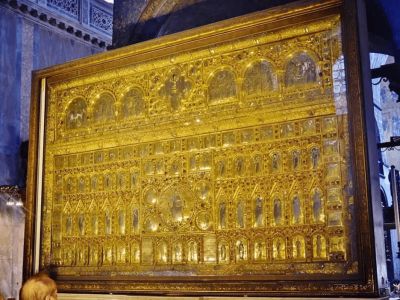I have a peculiar curiosity for death and the hereafter and a love of the peacefulness of cemeteries. So, on my travels, I have gravitated toward experiencing what most people think is bizarre, but I think is awesome.
The high altar of San Marco, the Pala d’Oro, is universally considered to be the most precious and refined expression of Byzantine genius elevating the cult of light. It holds high religious significance, and it is understood as the raising of man towards God. It glorifies John, the evangelist and contains his relics. The centerpiece is basically an altar screen of gold, studded with hundreds of gems. They include 1,300 pearls, 300 emeralds, 300 sapphires, 400 garnets, 100 amethysts, plus rubies and topazes.
I photographed a display case with the body of Saint Fausto in the Chiesa del Santissimo Salvatore in Castellina in Chianti, Italy. Originally from Albitina, North Africa, he was arrested for being a Christian and died a martyr in prison. The relics of his body which were originally buried in the catacombs of Rome, were donated by the Ugolini family, noble Florentines. After preparing the holy remains in a beautiful and decorative case, they were placed to rest in this church in 1661. San Fausto became the protector of Castellina and residents invoke his name to ward of epidemics, droughts, accidents, and earthquakes.
The Museo dell’Opera in Siena houses saints’ reliquaries and Medieval art. One of the first popes, St. Clement was martyred by being tied to an anchor and thrown off a ship. This reliquary is the size of a casket and has the complete skeleton of St. Clement the Martyr, adorned with golden flowers and pearls twining in and out of the bones.
Sant’Antonio Maria Gianelli is buried in the crypt of Cattedrale di Santa Maria Assunto in Bobbio, Italy. Due to his dedication to evangelization and preaching, he was given the title of Servant of God and is now the patron saint of Bobbio.
In 2005, while visiting Stresa on Lake Maggiore, we went to Isola Bella where we found another beautiful church which housed the body of San Vittore. His relics were originally in Milan but moved to Isola Madre. As the cult of Saint Victor lost its importance, the remains and the church were moved to Isola Bella, and then to Isola Pescatori, where they remain.
In Civitanova del Sannio, our family’s hometown, there are 900 people, 3 churches and one cemetery. The main church is Chiesa di San Silvestro Papa with the corpse of San Felice resting in its altar. He is their patron saint and every year at the end of August at La Festa di San Felice, the altar is carried through the streets and a three-day festival ensues.
Il Cimitero di Civitanova del Sannio has an ossuary cave where the bones of dead family members can be found. Many families could not afford to buy another spot above ground for a deceased family member so, after 50 years have passed, the remains of a relative in a crypt above ground are exhumed and placed in this cave and the now-empty crypt is ready for the newly dead.
La Chiesa di SS Silvestro e Martino ai Monti, a minor basilica in Rome, is very unassuming on the outside but inside is another amazingly ornate and beautiful church. Beato Angelo Paoli, known as the “father of the poor”, is buried here. Under the altar are the relics of Saints Artemius, Paulina and Sisinnius, brought here from the Catacomb of Priscilla. Near the front altar, there is a sign, “CRYPT,” with an arrow pointing down a very long set of stairs, and for the morbidly curious, lead lower and lower into very cold and damp rooms with crypts and the remains of San Silvestri and San Martino.
Next month, look for unique and unusual epitaths on the gravestones in Little Italy Cleveland’s Lakeview Cemetery.
-
 Crypt of Martyrs...
Crypt of Martyrs...
Crypt of Martyrs...
Crypt of Martyrs...
-
 Stairs to Underground...
Stairs to Underground...
Stairs to Underground...
Stairs to Underground...
-

-

-

-
 Altar, Pala d’Oro
Altar, Pala d’Oro
Altar, Pala d’Oro
Altar, Pala d’Oro
-
 Beato Angelo Paoli,...
Beato Angelo Paoli,...
Beato Angelo Paoli,...
Beato Angelo Paoli,...
-
 San Fausto, Castellina...
San Fausto, Castellina...
San Fausto, Castellina...
San Fausto, Castellina...
-
 St. Clement, Museo...
St. Clement, Museo...
St. Clement, Museo...
St. Clement, Museo...
-
 Sant’Antonio Maria Gianelli,...
Sant’Antonio Maria Gianelli,...
Sant’Antonio Maria Gianelli,...
Sant’Antonio Maria Gianelli,...
-

-
 Ossuary in Civitanova...
Ossuary in Civitanova...
Ossuary in Civitanova...
Ossuary in Civitanova...
https://www.lagazzettaitaliana.com/photo-exhibit/10374-more-of-the-bizarre-and-awesome-cults-catacombs-and-crypts#sigProIdb8f24af923



